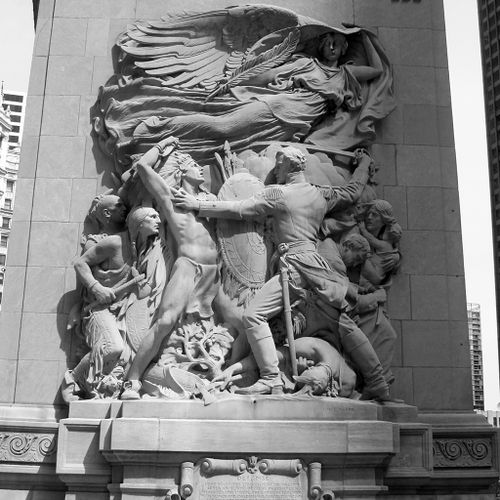The Defense

Title
The Defense
Date
1928
Artist
Henry Hering (1874-1947)
Location
DuSable Bridge
Context
As a relatively young city in the 1920s, Chicago sought to re- shape its image on the world’s stage by references to European culture and design elegance. The linking of the old central business district to a new Parisian-inspired commercial boulevard north of the Chicago River was made possible by an impressive bridge at Michigan Avenue. Parisian-influenced limestone-clad bridge towers at each corner were like giant gateposts, planned to incorporate high-relief stone sculpture representing Chicago’s historical origins as people and traffic approached. • NORTH END RELIEFS: Both of reliefs at the North end of the bridge were funded by William Wrigley Jr., whose monumental skyscraper adjoined the site. The sculptor was James Earle Fraser, whose reputation was as a well-known creator of sculptural works and for architectural installations that included the reliefs on the Supreme Court in Washington D.C. As part of a governmental initiative to create artistic coinage, Frasier was the creator of the “Buffalo” nickel first released in 1913. Fraser’s works are “The Discoverers” on the northeast tower – depicting French investigative expeditions to the Chicago area in the 17th century, and “The Pioneers” which represents early white permanent settlement. • SOUTH END RELIEFS: Both reliefs at the South end of the bridge were commissioned through the Benjamin F. Ferguson Monument Fund – established by a bequest from a wealthy lumber broker in 1905. Sculptor Henry Hering was a New York City-based artist and former Ecole des Beaux Arts student whose specialty was architectural sculpture. His work was much favored among East Coast architects creating classically based designs. In later works he adapted to modern stylized designs typical of the 1930s. Hering’s theme on the southwest tower is “The Defense” – an unsettling representation of the bloody confrontation between native tribes and a group of soldiers and settlers fleeing the vicinity of Fort Dearborn in 1812. On the southeast tower is a tableau representing the spirit of rebuilding following the Great Chicago Fire of 1871.